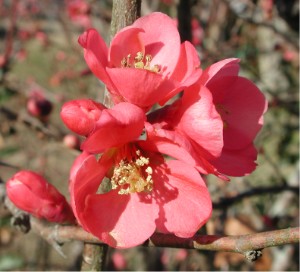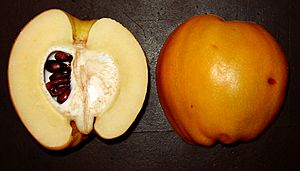Chaenomeles facts for kids
Quick facts for kids Chaenomeles |
|
|---|---|
 |
|
| Chaenomeles in flower, probably a cultivar of C. × superba | |
| Scientific classification |
|
| Kingdom: | Plantae |
| Clade: | Tracheophytes |
| Clade: | Angiosperms |
| Clade: | Eudicots |
| Clade: | Rosids |
| Order: | Rosales |
| Family: | Rosaceae |
| Subfamily: | Amygdaloideae |
| Tribe: | Maleae |
| Subtribe: | Malinae |
| Genus: | Chaenomeles Lindl. |
| Species | |
|
Chaenomeles cathayensis |
|
Chaenomeles (say: Kay-noh-MEE-leez) is a group of three types of shrubs. These shrubs lose their leaves in winter, have thorns, and usually grow about 1 to 3 meters (3 to 10 feet) tall. They belong to the Rosaceae family, which also includes roses and apples!
These plants originally come from Southeast Asia. They are related to the regular quince fruit and the Chinese quince. You can tell them apart because Chaenomeles plants have leaves with jagged edges that aren't fuzzy. Their flowers grow in bunches, and their sepals (the small leaf-like parts under the petals) fall off after the flower blooms.
The leaves of Chaenomeles grow one after another along the stem. They are simple leaves with saw-like edges. The flowers are about 3 to 4.5 centimeters (1.2 to 1.8 inches) wide and have five petals. They are usually bright orange-red, but can also be white or pink. These beautiful flowers bloom in late winter or early spring. The fruit is a type of pome (like an apple or pear) with five seed sections. It gets ripe in late autumn.
Some Lepidoptera (moths and butterflies) larvae, like the brown-tail moth and the Bucculatrix pomifoliella leaf-miner, eat Chaenomeles plants.
Contents
What Are Chaenomeles Called?
Even though all quince plants have flowers, gardeners often call Chaenomeles plants "flowering quince." This is because people usually grow them for their pretty flowers, not for their fruit.
These plants have also been called "Japanese quince." The name "japonica" (which refers to C. japonica) was very popular for these plants in the 1800s and 1900s. However, "japonica" is a common part of many plant names, so it's not very unique. The names "japonica" or "Japanese quince" are often used for all Chaenomeles plants, no matter their specific type. The most common Chaenomeles plants that people call "japonica" are actually a mix of different types, like C. × superba and C. speciosa. The C. japonica type itself isn't grown as often.
Types of Chaenomeles Plants
There are a few main types of Chaenomeles plants, plus some special mixes created by gardeners.
| Flowers | Fruit | Scientific Name | Common Name | Where They Grow | What They're Like |
|---|---|---|---|---|---|
 |
 |
Chaenomeles cathayensis | Western China, Bhutan, and Burma | This type has the biggest fruit, shaped like a pear. It can be 10–15 cm (4–6 inches) long and 6–9 cm (2.4–3.5 inches) wide. Its flowers are usually white or pink. The leaves are 7–14 cm (2.8–5.5 inches) long. | |
 |
 |
Chaenomeles japonica | Maule's quince or Japanese quince | Japan | This type has small, apple-shaped fruit, about 3–4 cm (1.2–1.6 inches) wide. Its flowers are usually red, but can also be white or pink. The leaves are 3–5 cm (1.2–2 inches) long. |
 |
 |
Chaenomeles speciosa | Chinese flowering quince | China and Korea | This type has hard, green, apple-shaped fruit, about 5–6 cm (2–2.4 inches) wide. Its flowers come in shades of red, white, or even mixed red and white. The leaves are 4–7 cm (1.6–2.8 inches) long. |
| Chaenomeles thibetica | Tibetan quince | Eastern Tibet and Western Sichuan | This type is found in high mountain areas. |
Gardeners have also created four special hybrid (mixed) types of Chaenomeles. The most common one is C. × superba, which is a mix of C. speciosa and C. japonica. Other hybrids include C. × vilmoriniana (a mix of C. speciosa and C. cathayensis) and C. × clarkiana (a mix of C. japonica and C. cathayensis). There's even a three-species hybrid called C. × californica (a mix of C. × superba and C. cathayensis). Many different kinds of these hybrids are sold in garden stores.
How People Use Chaenomeles
Chaenomeles plants have become popular ornamental shrubs in parts of Europe and North America. People grow them in their gardens because of their bright, colorful flowers. They can also be used as a thorny barrier to keep animals or people out of certain areas.
Some types of Chaenomeles can grow up to 2 meters (6.5 feet) tall, while others are much smaller and spread along the ground. The fruits are hard and not very tasty to eat raw. They taste a bit like an unripe apple with the sourness of a lemon. However, they become softer and less sour after a frost.
These fruits are great for making liqueurs, marmalade, and other preserves. This is because they have more pectin (a natural gelling agent) than apples or true quinces. Chaenomeles plants are also good for growing as bonsai trees, which are miniature trees grown in pots.
See also
 In Spanish: Chaenomeles para niños
In Spanish: Chaenomeles para niños


